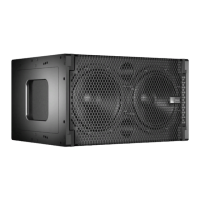M1D Rigging Grids and Accessories
PN: 05.115.001.01 B
Page 10 of 24
Meyer Sound Laboratories Inc.
www.meyersound.com
T: +1 510 486.1166
F: +1 510 486.8356
M1D Rigging Grids and Accessories
PN: 05.115.001.01 B
Page 11 of 24
Meyer Sound Laboratories Inc.
www.meyersound.com
T: +1 510 486.1166
F: +1 510 486.8356
MG-1D GRID IN FORWARD GROUND STACKED CONFIGURATION
This conguration is used for ground stacking a predominantly up tilted M1D and/or M1D-Sub array. It provides from
-14° to +14° of tilt in 2-degree increments between the MG-1D multipurpose grid and the rst loudspeaker when using
an M1D as the rst element of the array. The grid’s extension frame (located to the rear of the array) can be deployed
to provide a larger footprint towards the rear for improved stability.
Install the M1D grid cam as shown into the MG-1D grid. Please note that the grid side of the M1D grid cam faces the
MG-1D grid. Secure all cams with the quick release pins (QRPs), then install the M1D at the pre-determined angle. The
M1D grid cam is only used in transition from the MG-1D grid to the rst M1D/M1D-Sub. After this is complete, use the
M1D links with the QRPs to complete the rest of your array as shown.
NOTE: If the rst element of the
array is an M1D-Sub, the M1D grid
cam needs be reversed (grid side facing
the M1D-Sub). In this case, down tilt
from 0° to -14° in 2-degree increments is
possible. Use M1D links to complete the
rest of the array.
CAUTION: When ground stacking an M1D/M1D-Sub array on an MG-1D multipurpose grid, always
keep the center of gravity within the footprint of the leveling feet. For extra stability, the footprint can be
enlarged by use of the extension frame. To further secure larger arrays, particularly in outdoor situations, use a
tie down or extra weight on the grid, or a safety system on the array.

